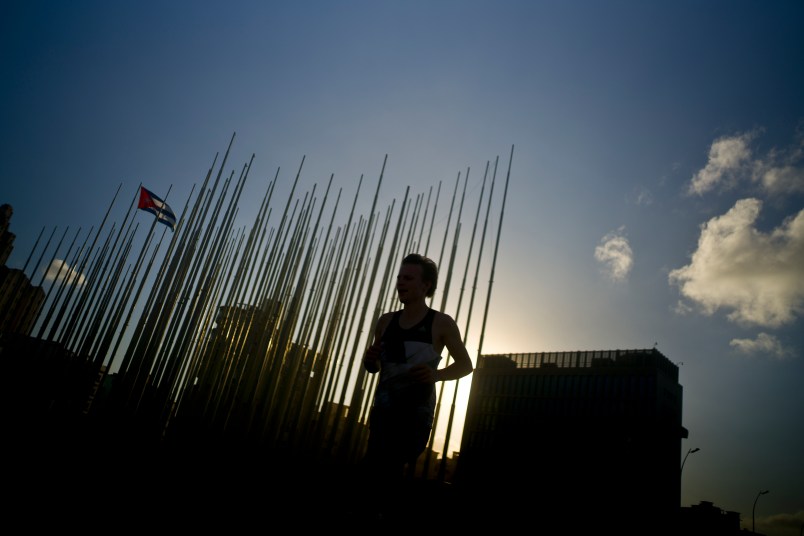PANAMA CITY (AP) — It took three months for Gabriel Marin and his wife, Yansiel, to make it from their home in eastern Cuba to this migrant shelter in Panama’s capital. The goal was the United States and now the door that spurred their odyssey has slammed shut.
Hundreds of people like Marin were stranded in transit in South and Central America on Thursday when President Barack Obama ended the so-called “wet foot, dry foot” policy that since 1995 has created a path to legal residency for thousands of Cubans who touched U.S. soil.
Marin and his wife were among 53 Cuban migrants at the Caritas shelter in Panama’s capital when the decision was announced. Most had arrived in recent weeks after slogging a similar route that involved a flight from Cuba to Guyana followed by traversing the jungles of Brazil, Peru, Ecuador and Colombia and finally a grueling hike across the Darien Gap into Panama.
“This has left us frozen, in total limbo, and sad because it wasn’t worth risking everything, our lives,” Marin, a 24-year-old cook wearing a Venezuelan soccer jersey said Thursday shortly after the news broke. Police in Peru near the Brazilian border had stolen $200 from them and now they were stuck.
“We can just wait and see what Trump can do,” Marin said, holding out hope that President-elect Donald Trump could reverse the change as part of a desire to dismantle the recent detente between the U.S. and Cuba. “I have a bunch of cousins waiting for me in the United States.”
Journalists arriving at the shelter seeking reaction conveyed the devastating news. Some of the Cubans sat in stunned silence, while others moved anxiously from one floor of the shelter to another with moist eyes.
Asked if they would now return to Cuba, a small group on the shelter’s patio chanted that they would not return dead or alive.
The most animated among them was 26-year-old Yancys Diaz, who left Havana in September with her mother and daughter
“In Cuba, we were harassed by the authorities. Now we can’t think about going back; someone has to help us get out of this,” Diaz said, smacking the shelter’s wall in frustration.
The “wet foot, dry foot” policy has irritated Cuba’s government for years and its end was negotiated for months. From one day to the next Cubans migrants to the U.S. went from a special class with special privileges to just like everyone else following the dangerous migrant routes through Central America and Mexico.
Cubans can still request humanitarian relief, but getting it is far from certain. Failing that, they will be deported, in many cases to an island where they sold their homes and possessions to fund the trip.
An estimated 100,000 Cubans have fled the island fearing the end of “wet foot, dry foot” since the announcement Dec. 17, 2014 that the U.S. and Cuba were re-establishing diplomatic relations.
But the exodus has created problems in Central America, especially when Nicaragua closed its border to Cubans in solidarity with the Havana government.
That stranded Cubans in Costa Rica and Panama, forcing Central American governments to fly Cubans in their countries to the Mexico-U.S. border.
Costa Rica last year flew more than 7,000 Cubans to El Salvador and Mexico to leapfrog Nicaragua. Government spokesman Mauricio Herrera said Costa Rica applauds Obama’s move and no longer makes special allowances for Cubans. In the second half of 2016, 300 Cubans were turned back at the Panamanian border while other groups caught entering the country illegally were deported.
Javier Carrillo, director of Panama’s National Immigration Service, said the flow of Cubans had slowed from its peak before the announcement. He estimated there were about 100 still in the country, though local media said there were far more.
On Thursday, about 80 Cubans set out from Turbo, Colombia for the border with Panama. Colombia, like Mexico and other countries, issues Cubans a document that allows for their legal transit through the country.
Those captured in Panama could now face deportation because they entered the country illegally, although some are seeking asylum to stay.
“Their dream and hope was to go to the United States, but that country closed the door. Panama does not have any responsibility,” Carrillo said.
Julio Hernandez, a heavy equipment operator from Cuba’s central province of Ciego de Avila, was traveling with his wife, Reicy.
“What life are we going to have if they deport us?” Hernandez asked. “We feared this would happen and sadly we find ourselves in a country where we can’t do anything.”
__
Associated Press writers Christopher Sherman in Mexico City and Alba Tobella in Bogota, Colombia contributed to this report.
Copyright 2017 The Associated Press. All rights reserved. This material may not be published, broadcast, rewritten or redistributed.






